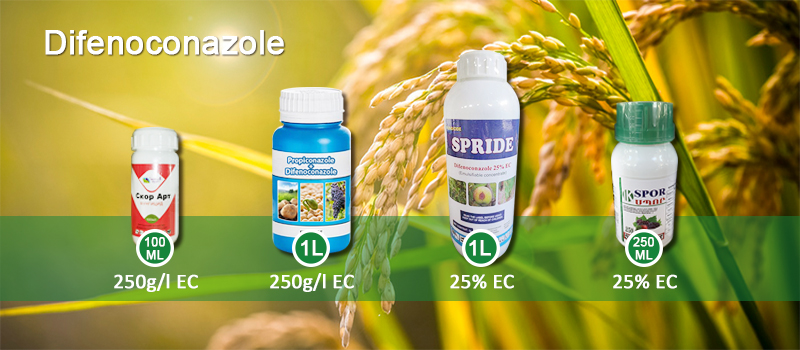How to ensure the efficacy of Difenoconazole
To ensure the efficacy of Difenoconazole, the following application methods and precautions can be followed:
Method of use:
Choose the right application period: Apply at the early stage of disease development or before the crop is susceptible to the disease. For example, for wheat powdery mildew and rust, spraying should be carried out at the early stage of disease onset; fruit tree diseases can be applied at critical periods such as the budding stage, before and after flowering.
Accurately formulate the concentration of the agent: strictly follow the dosage and dilution ratio recommended in the product manual. If the concentration is too high, it may cause drug damage to the crop, and if the concentration is too low, it will not achieve the ideal control effect.
Uniform spraying: Use a sprayer to spray the liquid evenly on the leaves, stalks, fruits and other parts of the crop to ensure full coverage so that the disease germs can fully come into contact with the agent.
Frequency and interval of application: According to the severity of the disease and the potency period of the agent, rationalize the frequency and interval of application. Generally, apply the medicine every 7-14 days, and apply the medicine 2-3 times continuously.
Precautions:
Reasonable mixing with other agents: it can be reasonably mixed with fungicides with different mechanisms of action to expand the spectrum of control, improve efficacy or delay the emergence of resistance. Before mixing, a small-scale test should be conducted to ensure that no adverse reactions will occur.
Weather conditions: Avoid application under adverse weather conditions such as high temperatures, strong winds and rainfall. High temperatures may increase the risk of damage, strong winds may cause the liquid to drift and reduce efficacy, and rainfall may wash away the liquid and affect the control effect. Generally choose to apply in windless, sunny weather, before 10:00 am or after 4:00 pm.
Safety protection: Applicators should wear protective clothing, masks, gloves and other equipment to avoid liquid contact with the skin and inhalation of the respiratory tract. Wash the body and change clothes in time after application.
Resistance Management: Continuous use of Difenoconazole over a long period of time may result in the development of resistance in pathogens. It is recommended to rotate the use of Difenoconazole with other types of fungicides or to adopt integrated control measures, such as crop rotation, reasonable planting density, and strengthening field management.
Storage and Custody: Store Difenoconazole in a cool, dry, well-ventilated place away from sources of ignition, food and children. Use the product according to its shelf life. Expired agents may reduce efficacy or create unknown risks.
For example, when controlling cucumber powdery mildew, use 10% Difenoconazole water-dispersible granules 1000-1500 times liquid for spraying at the early stage of the disease, spraying every 7-10 days, spraying 2-3 times in a row; when controlling apple spotted leaf drop disease, start spraying 7-10 days after blossom fall, using 40% Difenoconazole suspension 2000-3000 times liquid spray, spray every 10-15 days, spray 3-4 times in a row.

Difenoconazole mixing guide
Fungicides that can be mixed:
Protective fungicides: such as Mancozeb and Zinc, mixing can form a protective film to prevent the infestation of pathogens, to achieve the double effect of prevention and treatment.
Other triazole fungicides: such as tebuconazole, mixing should pay attention to the concentration, to avoid drug damage.
Methoxyacrylate fungicides: such as Azoxystrobin and Pyraclostrobin, bactericidal spectrum, high activity, mixing can improve the control effect and delay the emergence of resistance.
Amide fungicides: such as Fluopyram, mixing can enhance the control effect.
Insecticides that can be mixed:
Imidacloprid: good control of sucking mouthparts such as aphids, ticks and whiteflies.
Acetamiprid: It can control sucking mouthparts pests.
Matrine: plant-derived insecticide, mixing with Difenoconazole can expand the spectrum of control and realize the treatment of both diseases and insects.
Precautions when mixing:
Concentration ratio: strictly follow the recommended ratio in the product specification for mixing.
Mixing order: first dilute the respective agents with a small amount of water to form a mother liquor, then pour the mother liquor into the sprayer and mix it well, and finally add enough water for dilution.
Timing of application: According to the occurrence pattern and development stage of crop diseases, choose the appropriate timing of application.
Compatibility test: Conduct a small-scale test before large-scale application to observe whether there is any precipitation, delamination, discoloration and other phenomena to ensure safety and effectiveness.
Difenoconazole 12.5% + Pyrimethanil 25% SC is our mixing agent. The mixture of the two can complement each other’s advantages, expand the bactericidal spectrum, enhance the control effect and delay the emergence of drug resistance.
Post time: Jul-23-2024








